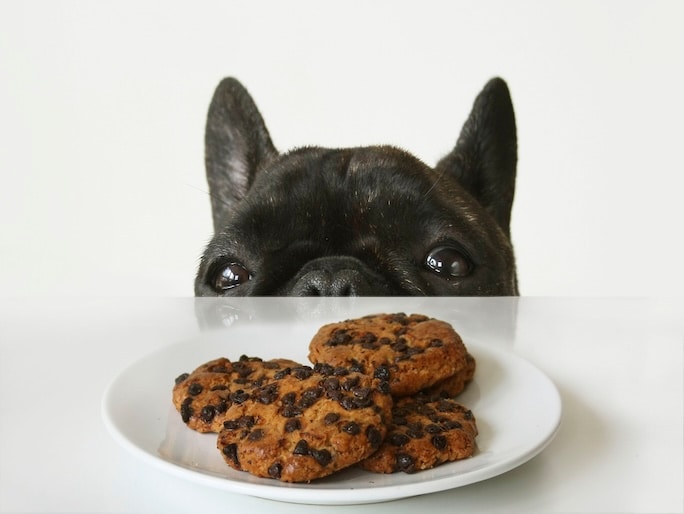Your chocolate stash is no longer a secret — and the treats that were once in it now reside inside your dog’s stomach. You know chocolate is harmful to dogs, so what’s your next move? As you stare down at your pup, all you can think is: “Will my dog be OK?”
In 2023, the ASPCA found chocolate to be the number four toxin dog toxin, making up 13% of the exposures seen last year.
You might be saying “my dog ate chocolate but is acting fine,” but are they? Here’s what you need to know about dogs and chocolate, symptoms of poisoning, when to call your vet and next steps if your dog has eaten small or large amounts chocolate.
Signs your dog at chocolate
You may have caught your dog in the act, or you might deduce it was the chocolate bandit by the wrappers left on the floor. But there are other ways to tell whether your dog ingested chocolate and if you have an emergency situation on your hands.
Symptoms to watch out for, according to Dr. Ed Blach, chief medical officer and co-founder of Vet24seven, are:
- Extreme thirst.
- Vomiting.
- Diarrhea.
- Muscle rigidity.
- Agitation.
- Hyperactive behavior.
- Excessive panting.
- Pacing.
- Seizures.
What to do if dog eats chocolate
If you suspect your dog ate chocolate, you should call your vet right away to assess the situation.
“Describe the amount of chocolate, the type of chocolate and the timing,” says Dr. Denise Petryk, director of veterinary services at Trupanion, and your vet can then tell you what to do.
“If your veterinarian confirms chocolate toxicity, they will most likely induce vomiting or administer activated charcoal,” says Blach.
Activated charcoal absorbs a toxin like chocolate and promotes its removal from the body via the bowels.
Can chocolate kill dogs?
Every dog owner should know that chocolate is toxic to dogs and cause serious illness, requiring a visit to the emergency vet. It can even kill a dog (though this is rare).
Why is chocolate so harmful to dogs?
“Chocolate contains two substances that are toxic to dogs: caffeine and theobromine,” says Blach.
He explains that because caffeine is a stimulant, when your dog ingests it, their heart could race or it could have a seizure. Theobromine, an alkaloid present in cocoa beans, acts as a diuretic, stimulant and even a relaxant for people, but it’s highly toxic to dogs.
Does the size of the dog and the amount of chocolate ingested matter?
The size of your dog plays a role in whether it shows symptoms. “A small amount of milk chocolate candies will typically not harm your Great Dane,” says Petryk.
But if your Yorkie ate that rich, dark chocolate bar you were saving for after dinner, or if your beagle lapped up all the cocoa powder you spilled on the floor during your cupcake baking session, your dog could suffer some serious problems.
“Chocolate toxicity is determined by the weight of the dog and how much chocolate was ingested,” says Dr. Chad Harris, chief of staff at North Austin Animal Hospital.
It’s always a good idea to check with your vet after a doggy chocolate episode, he says.
Can a dog eat chocolate without incident?
Some dogs can eat chocolate and then appear perfectly fine.
“If a dog ingests chocolate and does not show clinical signs, it’s simply because they did not ingest an amount of methylxanthines [the active ingredients in caffeine] high enough to cross the toxic threshold,” says Harris.
But keep in mind that all chocolate is harmful to dogs, and you should check with your vet regardless of how your dog acts. The more chocolate your dog eats, the more likely he will need treatment.
Are certain types of chocolate more dangerous than others?
There’s chocolate and then there’s chocolate — meaning that “different kinds of chocolates contain varying degrees of theobromine,” explains Blach.
The rule of thumb, he says, is the darker the chocolate, the greater the danger. White chocolate and milk chocolate, for example, contain less theobromine compared with dark chocolate. Baking chocolate has quite a bit of theobromine, and cocoa powder has the most of all.
Therefore it’s wise to keep all of these items out of reach of your pets to save yourself from a potential scare. Since most dogs will eat anything, help yours safe by keeping any and all chocolate in a secure place and warn people who care for your pet in your absence about the dangers associated with it.
The ASPCA Animal Poison Control Center hotline is a valuable resource available 24 hours a day, 365 days a year for animal poison-related emergencies. The center can be reached at 888-426-4435.

